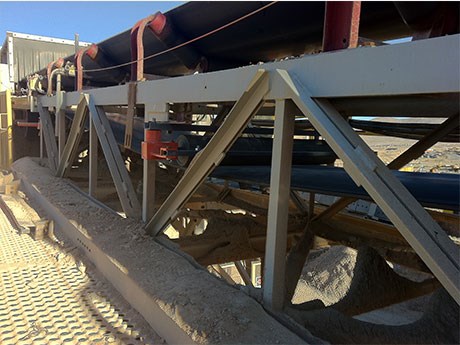Maintenance technician with 26 years of experience in the Timmins mining camp markets unique solution for conveyor belt alignment
Conveyor belts in the mining, oil sands and coal-burning power generation industries take a lot of punishment.
Dave Sharp, president of Timminsbased Conveyors Plus, knows this all too well, having spent 26 years as a mine maintenance technician looking after conveyor belts for Xstrata Copper.
A critical component of a mine’s material handling infrastructure, conveyor belts are also a weak link in the production process.
When they go out of alignment and get chewed up, everything grinds to a halt.
Sharp knew there was a need for a better belt tracking system and invented one that is now installed in mining operations across Canada, South America and Australia.
“After I got the idea, I built a conveyor model in my shop. The mine I was working at bought one on a trial, so I was able to monitor it. They were my first customer,” he said. “At first, the plan was to make one a month to cover my truck payments. It was a hobby, but it took off. After three years, I quit my job because I was working at the mine, coming home and then working in my shop until one in the morning to get my orders out.”
Word of mouth was responsible for the initial sales, but more and more inquiries from further afield came in when he launched a website and began attending trade shows in Peru, Chile and Australia.
Today, customers include Newmont Mining, Freeport-McMoRan, BHP Billiton, Barrick, Rio Tinto, Vale, Goldcorp, the Iron Ore Company of Canada, Brigus Gold, De Beers, Potash Corporation and oil sands operator Canadian Natural Resources.
Conveyor belt misalignment can occur for a number of reasons.
Oversize material, off-centre loading and belt damage caused by big drops when material transfers from one conveyor to another are common problems. So is splicing,
especially in underground mines, where “you’re only allowed to bring a certain size roll down and you’re limited in terms of belt length,” said Sharp. “Some belts may need 10 sections to make the full length, and the more sections there are, the more chances of problems you have if the splicing isn’t straight.”
Problems with the installation of the conveyor frame and buildup on the rollers and pulleys can also cause belts to wander, rub against the steel frame, rip and cause spillage. During the 26 years he had responsibility for the material handling systems at Xstrata, Sharp was well acquainted with the deficiencies of the belt tracking systems on the market and was determined to improve on them.
“I looked at all the problems the other trackers had,” he said. “Ninety to 95 per cent of them are installed on the bottom of the return side of the belt, so the belt sits on top of the roller, but that’s the dirty side caked with fugitive material that prevents good contact with the roller, which is necessary to steer the belt.
Contact is also problematic because the belt is troughed at the top and has a memory when it comes around on the return side, so you’re not getting the whole belt contacting the roller. My system is installed on the inside of the belt – the clean side with the roller pushing down on the belt to flatten it out.
“Another thing is my pivot parts that cause the roller to deflect back and forth for steering are installed away from any material that can block or interfere with them.
“Also, some trackers don’t have guide rollers, which activate the pivot parts to steer the belt. Some of them rely on the profile of the roller, but on the dirty side, what happens is the diameter of the roller changes - again due to buildup of fugitive material. On the inside, you don’t get that as much.” With Sharp’s patented Sure Align Tracker, when the conveyor belt wanders in either direction from the centre position, the guide rollers are engaged by the conveyor belt edge and laterally move the crosslink.
That, in turn, causes the pivot members to rotate and the steering roller to move in the direction needed to correct the misalignment.
Sharp does all of his own manufacturing as well as the installations.
Installations
“It’s very important to do the installations ourselves,” he notes. “I even flew to Chile to do two installs for free because the track record is 100 per cent when I’m there. Like any conveyor component, when it’s put in properly, it will shine. It’s especially important if the customer is doing a trial because you
want to make sure it works to win repeat business.”
The opportunities for Conveyors Plus are limitless given the ubiquity of conveyor belts in mining, coalfired generating stations, the oil sands, shiploading, the aggregate industry and even agriculture. “We’re real big in the oil sands,” said Sharp. “I’ve seen thousands of conveyor belts and I’ve been to probably hundreds of mine sites and the oil sands are by far the harshest environment.”
To take advantage of these and other opportunities, Sharp participated in the Ministry of Northern Development and Mines’ Mining Supply and Service Export Assistance Program and has hired a business development consultant to take Conveyors Plus to the next level. In April, he attended the Expomin show in Santiago, Chile, and is in the process of patenting several new products for conveyor belt applications.



